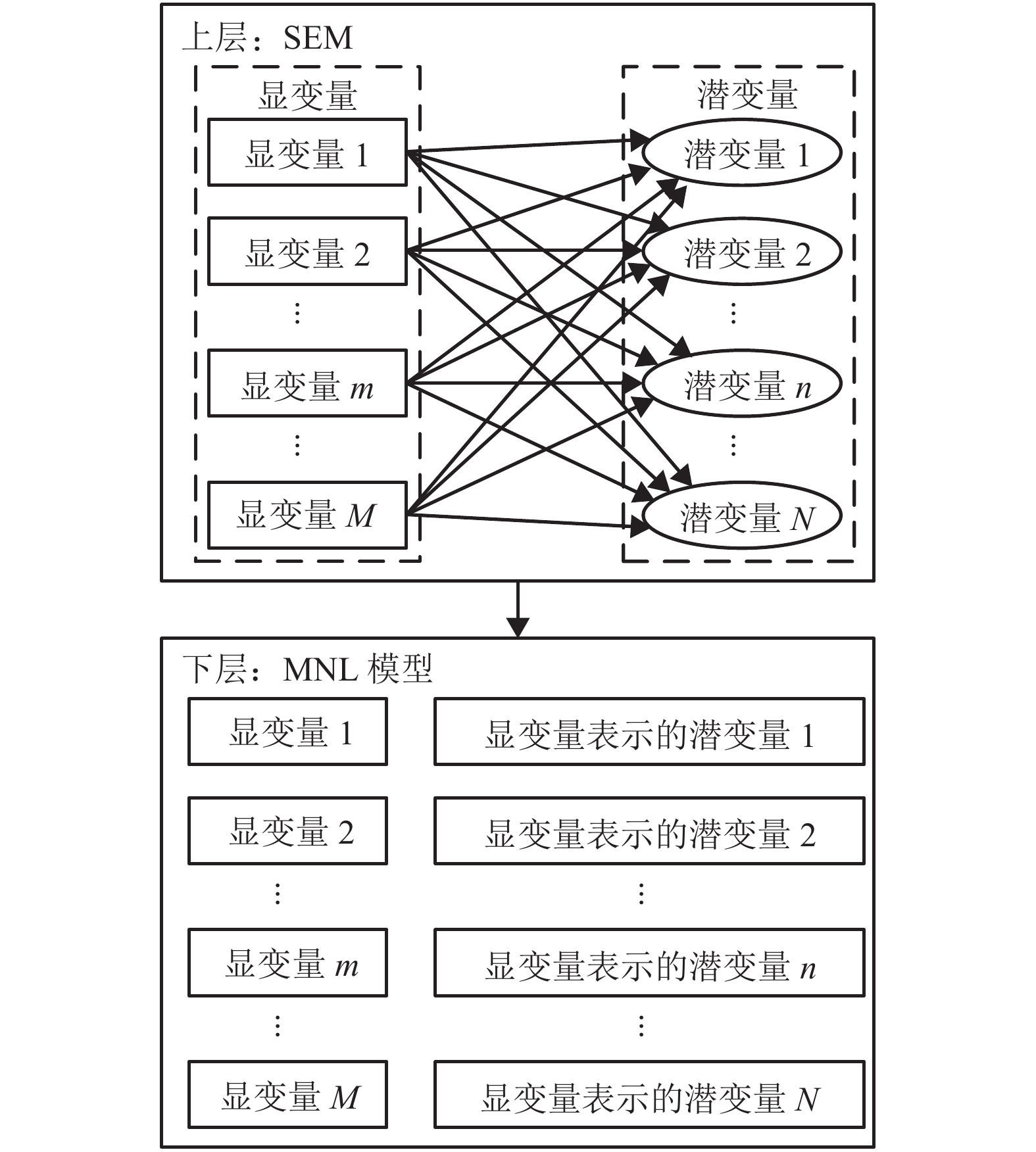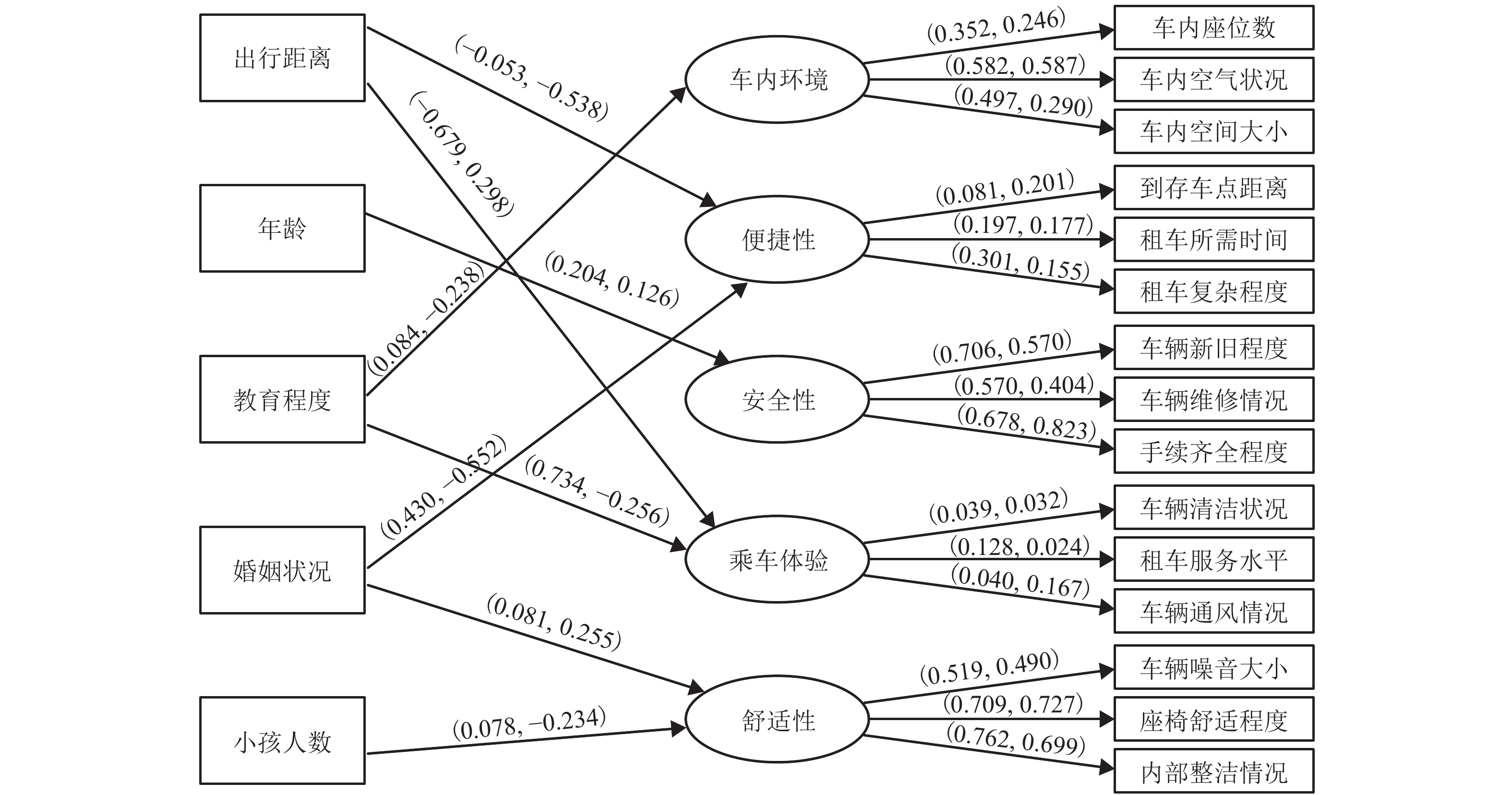Leasing Behavior for Autonomous VehiclesConsidering Latent Variables
-
摘要:
将自动驾驶汽车(autonomous vehicle,AV)与分时租赁、点对点(peer-to-peer,P2P)租赁模式相结合,为出行者提供新型的出行方式. 为探究出行者租赁自动驾驶汽车的行为特征,分析出行者对AV分时租赁、AV P2P租赁、私家车、公共交通的选择意愿及其影响因素. 基于出行方式选择意愿的调查数据,将结构方程模型(structural equation model,SEM)与多项Logit (multinomial Logit,MNL)模型相结合,建立同时标定显变量与潜变量参数的结构方程-多项Logit (structural equation-multinomial Logit,SE-MNL)模型,对比分析了MNL与SE-MNL模型的参数标定结果. 研究结果表明:在95%的置信水平下,显变量中的出行费用、车内时间、驾照情况、出行目的、婚姻状况以及潜变量中的便捷性、安全性、乘车体验、舒适性对出行者选择AV分时租赁或P2P租赁的影响都是显著的;SE-MNL模型的拟合度较MNL模型高出2%~3%.
-
关键词:
- 交通工程 /
- 机动化交通 /
- 自动驾驶汽车 /
- 出行方式选择 /
- 结构方程-多项Logit模型
Abstract:Combining autonomous vehicle (AV) with time-sharing leasing or peer-to-peer (P2P) leasing, two novel travel modes are provided for travelers. To explore the behavior characteristics of AV rental, travelers’ preferences and influence factors for choosing AV time-sharing leasing, AV P2P leasing, private cars and public transit are analyzed. Based on the preference survey data of travel mode choice, the structural equation-multinomial Logit (SE-MNL) model combining structural equation model (SEM) with multinomial Logit (MNL) model is established, which calibrates the parameters of the observed and latent variables. The comparative analyses are done for the parameter calibration results of the MNL and SE-MNL models. The results show that at 95% confidence level, both the observed variables of travel cost, in-vehicle time, driver’s license status, travel purpose, marital status and the latent variables of convenience, safety, ride experience, ride comfort have significant effects on travelers’ choice of AV time-sharing leasing or P2P leasing. The goodness of fit of the SE-MNL model is 2%~3% higher than that of the MNL model.
-
近些年,人们越来越关注自动驾驶汽车(autonomous vehicle,AV),国内外各大汽车厂商、互联网公司纷纷致力于AV的研发、生产、测试及试运营,极大地推动了AV及其技术的蓬勃发展. 由于初期投入资金较多,AV至少在起步阶段很昂贵. 此时,AV租赁势必会为出行者提供一种选择.
分时租赁和点对点(peer-to-peer,P2P)租赁是租车行业中两种典型的运营模式. 将分时或P2P租赁与AV相结合,形成AV分时租赁与AV P2P租赁两种新的商业模式,为出行者提供两种新型的出行方式,其优势在于未购买AV的人群通过支付少许车辆使用费就可享受AV的便利.
AV租赁模式可融合AV与汽车租赁的优点,是一种共享自动驾驶汽车(shared autonomous vehicle,SAV)商业运营模式. 当前,较多研究关注汽车租赁意愿和SAV市场接受度,但很少有研究探讨AV租赁的市场接受度.
有关汽车租赁意愿,许多学者使用不同城市的调查数据探讨了影响人们租赁汽车的各种因素,并采用混合Logit、条件Logit等离散选择模型对所选数据进行建模分析,结果显示人们在非通勤出行时更愿意选择租车、共享出租车和自由浮动式租车等方式[1-2]. 与汽车租赁非常相关的是汽车共享. 有关汽车共享使用意愿,研究人员针对不同类型车辆、汽车共享发展阶段及不同年龄段讨论了影响人们选择汽车共享的各种因素[3-6]. 有研究分析了共享电动汽车的上车距离和剩余电量对出行者方式选择行为的影响[3]. 杭州市的调查[4]表明,50%的受访者愿意尝试使用汽车共享而推迟购买汽车;韩国首尔的汽车共享计划发现,选择汽车共享而放弃私家车的会员从早期阶段的2.3%增加至成熟阶段的4.3%[5]. 还有研究[6]显示,受过高等教育的年轻成年人比其他群体更倾向于使用按需乘车服务. 唐立等[7]使用混合Logit模型分析了出行者使用网约车的意愿,并对出租车和网约车的费用进行了边际效应分析,明确了价格对出行结构的影响.
有关SAV市场接受度,研究者为有(无)私家车受访者提供包括私家车、私人AV、SAV (公共交通、私人AV、SAV)的出行方式选择集,探究了人们选择SAV的意愿以及影响因素[8-10],还讨论了安全性、环保性等潜在因素[11]. 这些研究并没有全面考虑各种潜在因素,而且建模时仅单独使用Logit模型或结构方程模型(structural equation model,SEM),以致难以发挥Logit模型和SEM各自的优势. 事实上,出行者的心理状态及其对车内时间的感知程度也会影响出行者选择某种出行方式. 朱顺应等[12]使用模糊化的出行时间建立了忽略出行成本且含模糊特性变量的出行方式预测Logit模型. 李聪颖等[13]探讨了自行车骑行者生理、心理与综合负荷感知的特性及规律. 刘志伟等[14]同时考虑了出行选择偏好的异质性和心理因素对出行方式选择的影响.
综上,对于出行者方式选择行为,简单可行的Logit模型的使用频率较高,但是该模型存在无法揭示潜在因素(如认知态度、心理状态等)的明显缺陷. 然而,此类潜在因素对AV租赁行为又至关重要. 考虑历史出行行为、出行方式特性、认知态度特征及社会经济属性四方面因素研究出行者对AV分时租赁、AV P2P租赁、私家车、公共交通的选择偏好. 为提取影响出行者选择行为的潜在因素,融合SEM和多项Logit (multinomial Logit,MNL)模型,建立描述AV租赁行为的结构方程-多项Logit (structural equation-multinomial Logit,SE-MNL)模型,分析SE-MNL和MNL模型的参数标定结果,为未来AV运营模式及市场开发提供参考.
1. Logit模型
1.1 MNL模型
离散选择模型认为,某种出行方式对某一出行者的效用由固定效用和随机效用组成[15],即
Uit=Vit+εit, (1) 式中:Uit、Vit、εit分别为出行方式i对出行者t的效用、固定效用、随机效用.
通常,固定效用可表达为若干种影响因素(解释变量或自变量)的线性组合. MNL模型仅考虑显变量(可观测变量),则固定效用[15]为
VOit=M∑m=1αmXitm, (2) 式中:VOit为不考虑潜变量时出行方式i对出行者t的固定效用;αm为第m种显变量的参数;M为显变量个数;Xitm为出行方式i对出行者t涉及的第m种显变量,这里引入出行方式特性以及出行者的历史出行行为与社会经济属性.
MNL模型认为随机效用服从独立极值(Gumbel)分布,而且自变量的参数均为常数. 那么,基于效用最大化原则所得的出行者t在显变量影响下选择出行方式i的概率[15]为
POit=eVOit/Jt∑j=1eVOjt, (3) 式中:Jt为出行者t的可选出行方式数.
1.2 SE-MNL模型
事实上,出行方式选择行为的影响因素并非都是显变量,有时是潜变量(不可观测变量). SEM是一种多元统计分析方法,描述显变量与潜变量及潜变量之间的关系[16]. 对出行者从多种出行方式中选择其一,当同时考虑显变量与潜变量,可融合SEM与MNL模型. 此时,固定效用函数同时包含显变量和潜变量,则式(2)变形为
VLit=M∑m=1αmXitm+N∑n=1βnZitn, (4) 式中:VLit为考虑潜变量时出行方式i对出行者t的固定效用;βn为第n种潜变量的参数;N为潜变量个数;Zitn为出行方式i对出行者t涉及的第n种潜变量,这里引入出行方式的车内环境、便捷性、安全性、乘车体验和舒适性.
为估计潜变量的参数,需要建立潜变量与显变量之间的相关关系. 根据结构方程模型,潜变量与显变量之间的关系可表达为
Zitn=Mp∑p=1γpXRitp+ξitp,Mp⩽M, (5) 式中:γp为测度潜变量与显变量相关关系的第p个载荷值;Mp为测度潜变量的显变量个数;XRitp为出行方式i对出行者t涉及与潜变量有相关关系的第p种显变量;ξitp为出行方式i对出行者t测度潜变量与显变量之间误差的第p项值.
融合SEM与MNL模型时,依然假设随机效用服从独立极值(Gumbel)分布且自变量(包括显变量和潜变量)的参数均为常数,所建新模型称为SE-MNL模型. 此时,出行者t在潜变量与显变量的共同影响下选择出行方式i的概率为
PLit=eVLit/Jt∑j=1eVLjt. (6) SE-MNL模型采用如图1所示的双层结构,上层利用SEM描述显变量与潜变量的逻辑关系(通常显示为路径图),一般需要根据修正指标获得各条路径上的载荷值;下层采用MNL模型表达显变量与由显变量表示的潜变量之间的关系,再进行参数标定和假设检验,进而获得各种出行方式的选择效用和选择概率.
2. 问卷设计及数据获取
2.1 问卷设计
为探讨出行者对AV分时和P2P租赁两种新型AV租赁模式的接受程度及使用意愿,所设计的调查问卷依次涉及历史出行行为、出行方式特性、认知态度特征及社会经济属性4类.
历史出行行为调查了解出行者拥有驾照情况及其家庭拥有私家车情况、最近一周的出行次数和费用、每次出行的里程及主要出行目的. 认知态度特征调查将潜在影响因素分为车内环境、便捷性、安全性、乘车体验和舒适性[17],为每一特征设置3个水平(情境问题),再了解受访者对所提问题的赞成程度. 社会经济属性调查了解受访者的基本情况.
出行方式特性调查属于意愿(stated preference,SP)调查,将受访者按其家庭拥有私家车情况分为有私家车人群和无私家车人群. 前者选择的出行方式有私家车、AV分时租赁和AV P2P租赁;后者选择的出行方式有公交/地铁/轻轨、AV分时租赁和AV P2P租赁. 表1列出了SP调查考虑的影响因素及其水平值.
表 1 出行方式选择影响因素及水平值Table 1. Influencing factors and their levels for travel mode choice影响
因素出行
方式因素水平值 水平 1 水平 2 水平 3 出行费用
/元私家车 10 15 20 AV 分时租赁 20 30 40 AV P2P 租赁 15 25 35 公交/地铁/轻轨 2 4 6 车内时间
/min私家车 30 45 60 AV 分时租赁 30 40 50 AV P2P 租赁 35 45 55 公交/地铁/轻轨 60 70 80 等待时间
/minAV 分时租赁 1 3 5 AV P2P 租赁 1 3 5 公交/地铁/轻轨 2 6 10 停车费用/元 私家车 0 10 20 为提高SP调查效率,设计正交试验方案后删除具有明显优势的方案. 结果,针对有、无私家车人群分别设置18个和27个SP情境问题. 进一步,将这些情境问题平分后设置3套问卷.
2.2 数据获取
考虑到线上调查具有成本低、回收速度快、可结构化设置问题等优势,采用问卷星和社交软件(如微信、QQ等)发放问卷,一共回收了565份问卷. 经过数据预处理,有效问卷为459份,有效率为81.2%.
有、无私家车人群的有效问卷分别为348份和111份,其每份问卷分别有6个和9个SP情境问题,则所得SP有效问卷分别有2088份和999份. 表2给出了基于有效数据得到的受访者的社会经济属性的描述性统计结果.
表 2 社会经济属性的描述性统计结果Table 2. Descriptive statistical results of socio-economic attributes因素 取值 有私家车
人群占比/%无私家车
人群占比/%性别 男 44.3 45.0 女 55.7 55.0 年龄 18~30 岁 50.6 87.4 31~45 岁 33.6 6.3 46~65 岁 13.2 5.4 > 65 岁 2.6 0.9 职业 学生 31.6 46.9 上班族 49.7 28.8 自由职业者 9.5 6.3 其他职业者 9.2 18.0 教育程度 高中及以下 10.6 6.3 大专 16.9 9.9 本科 44.3 45.0 硕士及以上 28.2 38.8 婚姻状况 未婚 48.9 86.5 已婚 51.1 13.5 住房情况 租房 20.7 27.0 自有住房 51.1 18.9 住宿舍 28.2 54.1 小孩数 0 人 54.0 90.1 1 人 35.4 9.0 ≥ 2 人 10.6 0.9 月收入 < 3000 元 33.3 54.1 3000~5999 元 27.9 27.0 6000~9999 元 23.3 9.9 ≥ 10000 元 15.5 9.0 从表2可见:有、无私家车人群中18~45岁的青年受访者分别占84.2%和93.7%,即受访者中青年人占比很高. 为更有针对性地研究,进一步提取有效问卷中18~45岁青年人的397份样本,重点分析青年人选择租赁AV的意愿.
3. AV租赁行为建模及分析
3.1 模型变量关系分析
使用历史出行行为变量、出行方式特性变量、认知态度特征变量和社会经济属性变量分别表示问卷调查的各部分内容. 认知态度特征受个体主观感受影响而不可直接观测,因此认知态度特征变量属于潜变量. 其余三类变量都可直接观测,均属于显变量. 采用SEM建立显变量与潜变量之间的逻辑关系,进而使用显变量表示潜变量,然后探讨潜变量对出行者选择AV租赁模式的影响. 利用AMOS软件经过多次修正后所得的显变量与潜变量的关系路径如图2所示,该图基于SEM确定显变量与潜变量的逻辑关系,进而得到各条路径上的载荷值. 图2为SE-MNL模型上层显变量与潜变量的关系路径,所得结果用于SE-MNL模型下层的参数标定.
图2中,长方形和椭圆所示变量分别为显变量和潜变量,单向箭头代表显变量与潜变量之间存在因果关系,箭头处括号内所标数字分别表示针对有、无私家车青年人所得参数值,这里包括由SEM标定所得的两类参数值. 第一类参数值是由出行距离、年龄、教育程度、婚姻状况和小孩人数这些显变量指向潜变量,为显变量表示潜变量的参数值;第二类参数值是由车内环境、便捷性、安全性、乘车体验和舒适性这些潜变量指向车内座位数等15种显变量的参数值. 此处描述显变量与潜变量关系的模型也称为测量模型,属于验证性因素分析.
从第一类参数值可知:随出行距离增加,青年人越来越不关注AV分时和P2P租赁方式的便捷性;随年龄增加,青年人更看重AV分时和P2P租赁方式的安全性;受教育程度越高的有私家车青年人,或者受教育程度越低的无私家车青年人,越注重AV分时和P2P租赁方式的车内环境和乘车体验;已婚青年人更关注AV分时和P2P租赁方式的舒适性;有私家车的已婚青年人比无私家车的已婚青年人更关注AV分时和P2P租赁方式的便捷性;随出行距离增加,有私家车青年人越来越不关注AV分时和P2P租赁方式的乘车体验,而无私家车青年人越来越关注AV分时和P2P租赁方式的乘车体验;相比无私家车青年人,有私家车青年人随小孩人数增加而越来越关注AV分时和P2P租赁方式的舒适性.
从第二类参数值可知:车内空气状况最能表征AV分时和P2P租赁方式的车内环境. 针对有私家车青年人,租车复杂程度最能代表AV分时和P2P租赁方式的便捷性;车辆新旧程度最能表征AV分时和P2P租赁方式的安全性;租车服务水平最能代表AV分时和P2P租赁方式的乘车体验;内部整洁情况最能表征AV分时和P2P租赁方式的舒适性. 针对无私家车青年人,到存车点距离最能代表AV分时和P2P租赁方式的便捷性;手续齐全程度最能表征AV分时和P2P租赁方式的安全性;车辆通风情况最能体现AV分时和P2P租赁方式的乘车体验;座椅舒适程度最能表征AV分时和P2P租赁方式的舒适性.
3.2 模型参数标定结果
TransCAD软件为出行方式选择行为分析提供了包括MNL模型的多种离散选择模型,其中采用极大似然估计法(method of maximum likelihood)标定离散选择模型中各变量的参数值. 软件内部是经过若干次迭代后输出出现概率最大的参数值,并使用t检验确定各变量的显著性.
本研究选用TransCAD软件标定MNL模型和SE-MNL模型下层的参数. 具体来说,使用MNL和SE-MNL两种模型分别分析调查所得的青年受访者的有效数据. 使用MNL模型时,考虑历史出行行为、出行方式特性与社会经济属性,这里借助TransCAD软件获得不含潜变量模型的参数标定结果. 使用SE-MNL模型时,增加认知态度特征,这里借助AMOS软件由SEM得到含潜变量的所有显变量,再采用TransCAD软件获取含潜变量模型的参数标定结果.
表3对比了MNL和SE-MNL两种模型对出行方式选择和历史出行行为的标定结果. 从表3可以看出:1) 随着出行费用、车内时间、等待时间或停车费用的增加,青年人明显越来越倾向于放弃AV分时和P2P租赁方式;2) 有私家车且有驾照和无私家车且无驾照的青年人明显愿意选择AV分时和P2P租赁方式;3) 周出行频率越高,有私家车青年人越倾向于选择AV分时和P2P租赁方式;4) 日均出行距离越远,无私家车青年人越不愿意选择AV分时和P2P租赁方式;5) 周出行费用越高,有私家车青年人越愿意选择AV分时和P2P租赁方式;6) 无论何种出行目的,有私家车青年人倾向于选择私家车而不是AV分时和P2P租赁方式;当上班/上学、外出业务时,无私家车青年人可能愿意选择AV分时和P2P租赁方式;当购物/休闲/娱乐时,无私家车青年人可能不愿意选择AV分时和P2P租赁方式.
表 3 MNL与SE-MNL模型对出行方式选择和历史出行行为的标定结果Table 3. Calibration results of MNL and SE-MNL models for travel mode choice and historical travel behavior变量名称 有私家车青年人 无私家车青年人 MNL 模型参数值 SE-MNL 模型参数值 MNL 模型
t 检验值SE-MNL 模型
t 检验值MNL 模型参数值 SE-MNL 模型参数值 MNL 模型
t 检验值SE-MNL 模型
t 检验值常数项 0.022 0.024 0.273 0.047 −0.215 6.300 −1.858 2.548* 出行费用 −0.054 −0.051 −11.167* −10.476* −0.068 −0.071 −8.566* −8.802* 车内时间 −0.027 −0.026 −7.753* −7.667* −0.052 −0.052 −8.231* −8.102* 等待时间 −0.044 −0.045 −6.380* −1.706 −0.017 −0.018 −0.851 −0.887 停车费用 −0.035 −0.043 −1.364 −6.307* 驾照情况 0.520 0.519 3.739* 3.725* −1.073 −1.079 −6.231* −6.246* 每周平均出行数 ≤ 10 次 0.719 0.720 4.077* 4.000* −0.294 −0.326 −0.992 −1.099 每周平均出行数 > 10 次 0.204 0.208 1.075 1.086 −0.254 −0.273 −0.734 −0.786 日均出行
距离0.007 0.006 0.943 0.592 −0.049 −0.055 −3.315* −3.256* 周出行费用 0.017 0.017 3.521* 3.474* −0.011 −0.011 −1.312 −1.351 上班、上学 −0.770 −0.762 −2.439* −2.137* −1.590 5.275 −1.882 2.046* 外出业务 −0.790 −0.782 −2.293* −2.048* −1.447 5.410 −1.570 2.074* 购物、休闲、
娱乐−1.396 −1.387 −4.152* −3.733* −2.042 4.820 −2.349* 1.865 探亲访友 −1.070 −1.054 −2.873* −2.641* −1.737 5.096 −1.694 1.935 注:*表示显著性水平为0.05时该项为显著性因素,后同. 表4对比了MNL和SE-MNL两种模型对社会经济属性和认知态度特征的标定结果. 从表4可以看出:1) 女性和小孩多的无私家车青年人更倾向于选择AV分时和P2P租赁方式;2) 年龄越长的无私家车青年人可能更愿意选择AV分时和P2P租赁方式;3) 无私家车青年人中,学生、上班族和其他职业者更愿意选择AV分时和P2P租赁方式;4) 受教育程度越低的有私家车青年人越愿意选择AV分时和P2P租赁方式;5) 已婚青年人更愿意选择AV分时和P2P租赁方式;6) 有、无私家车青年人选择AV分时和P2P租赁方式时都明显看重安全性和舒适性,同时无私家车青年人还关注AV分时和P2P租赁方式的便捷性和乘车体验.
表 4 MNL与SE-MNL模型对社会经济属性和认知态度特征的标定结果Table 4. Calibration results of MNL and SE-MNL models for socio-economic attributes and cognition-attitude characteristics变量名称 有私家车青年人 无私家车青年人 MNL 模型
参数值SE-MNL 模
型参数值MNL 模型
t 检验值SE-MNL 模
型 t 检验值MNL 模型
参数值SE-MNL 模
型参数值MNL模型
t 检验值SE-MNL 模型
t 检验值性别 0.193 0.195 1.754 1.769 0.451 0.455 2.725* 2.742* 年龄 0.014 0.161 0.090 0.792 0.617 1.455 1.017 2.094* 学生 0.442 0.445 1.882 1.864 1.435 1.457 5.483* 5.544* 上班族 −0.312 −0.309 −1.334 −1.310 1.010 1.034 3.769* 3.852* 自由职业者 −0.116 −0.111 −0.426 −0.404 −0.101 −0.096 −0.282 −0.266 其他职业者 −0.420 −0.413 −1.427 −1.389 1.393 1.399 3.315* 3.310* 教育程度 −0.547 −0.551 −3.875* −3.160* −0.198 −0.588 −0.723 −1.550 婚姻状况 0.545 0.441 2.665* 1.763 3.566 3.668 5.378* 5.141* 自有住房 0.310 0.308 1.919 1.907 0.206 0.191 0.909 0.842 住宿舍 0.242 0.226 0.776 0.722 小孩数 −0.302 −0.291 −1.756 −1.467 2.943 2.101 4.373* 3.038* 车内环境 −0.678 −0.296 −6.195 −1.371 便捷性 −0.596 −1.056 4.484 2.079* 安全性 1.530 1.971* 13.488 2.357* 乘车体验 0.051 1.024 8.053 2.063* 舒适性 0.149 2.005* 9.047 2.867* 对于有、无私家车青年人,MNL和SE-MNL模型的拟合度分别为0.167和0.170、0.275和0.284,这说明引入潜变量能够更好地描述出行者选择AV分时和P2P租赁方式的行为.
4. 结 论
融合结构方程模型和多项Logit模型分析了青年人对自动驾驶汽车分时和P2P两种新型租赁模式的选择意愿. 通过研究,可得如下结论:
1) SE-MNL模型通过引入潜变量融合了结构方程模型与MNL模型,弥补了MNL模型无法反映潜在因素影响出行者方式选择行为的缺陷.
2) 对有、无私家车青年人,SE-MNL模型比MNL模型的拟合度分别高出1.8%和3.3%,说明分析AV租赁行为时应特别关注某些潜在因素.
从表2可见:有、无私家车人群中18~45岁的青年受访者分别占84.2%和93.7%,即受访者中青年人占比很高. 为更有针对性地研究,进一步提取有效问卷中18~45岁青年人的397份样本,重点分析青年人选择租赁AV的意愿.
3) 出行费用、车内时间、驾照情况、出行目的和婚姻状况以及AV的便捷性、安全性、舒适性和出行者的乘车体验都是影响青年人选择新型AV租赁方式的显著性因素,尤其是无法直接观测的那些潜在因素,这些发现有助于完善AV租赁市场的运营模式.
由于受调查方式及经费所限,本研究采集的样本主要集中于18~45岁的青年人,故研究结果可能不适用于青年人以外的其他人群. 后续研究将采用多种抽样方式,并扩大抽样范围,以便更全面地分析不同年龄段的各类人群对自动驾驶租赁方式的选择意愿.
-
表 1 出行方式选择影响因素及水平值
Table 1. Influencing factors and their levels for travel mode choice
影响
因素出行
方式因素水平值 水平 1 水平 2 水平 3 出行费用
/元私家车 10 15 20 AV 分时租赁 20 30 40 AV P2P 租赁 15 25 35 公交/地铁/轻轨 2 4 6 车内时间
/min私家车 30 45 60 AV 分时租赁 30 40 50 AV P2P 租赁 35 45 55 公交/地铁/轻轨 60 70 80 等待时间
/minAV 分时租赁 1 3 5 AV P2P 租赁 1 3 5 公交/地铁/轻轨 2 6 10 停车费用/元 私家车 0 10 20 表 2 社会经济属性的描述性统计结果
Table 2. Descriptive statistical results of socio-economic attributes
因素 取值 有私家车
人群占比/%无私家车
人群占比/%性别 男 44.3 45.0 女 55.7 55.0 年龄 18~30 岁 50.6 87.4 31~45 岁 33.6 6.3 46~65 岁 13.2 5.4 > 65 岁 2.6 0.9 职业 学生 31.6 46.9 上班族 49.7 28.8 自由职业者 9.5 6.3 其他职业者 9.2 18.0 教育程度 高中及以下 10.6 6.3 大专 16.9 9.9 本科 44.3 45.0 硕士及以上 28.2 38.8 婚姻状况 未婚 48.9 86.5 已婚 51.1 13.5 住房情况 租房 20.7 27.0 自有住房 51.1 18.9 住宿舍 28.2 54.1 小孩数 0 人 54.0 90.1 1 人 35.4 9.0 ≥ 2 人 10.6 0.9 月收入 < 3000 元 33.3 54.1 3000~5999 元 27.9 27.0 6000~9999 元 23.3 9.9 ≥ 10000 元 15.5 9.0 表 3 MNL与SE-MNL模型对出行方式选择和历史出行行为的标定结果
Table 3. Calibration results of MNL and SE-MNL models for travel mode choice and historical travel behavior
变量名称 有私家车青年人 无私家车青年人 MNL 模型参数值 SE-MNL 模型参数值 MNL 模型
t 检验值SE-MNL 模型
t 检验值MNL 模型参数值 SE-MNL 模型参数值 MNL 模型
t 检验值SE-MNL 模型
t 检验值常数项 0.022 0.024 0.273 0.047 −0.215 6.300 −1.858 2.548* 出行费用 −0.054 −0.051 −11.167* −10.476* −0.068 −0.071 −8.566* −8.802* 车内时间 −0.027 −0.026 −7.753* −7.667* −0.052 −0.052 −8.231* −8.102* 等待时间 −0.044 −0.045 −6.380* −1.706 −0.017 −0.018 −0.851 −0.887 停车费用 −0.035 −0.043 −1.364 −6.307* 驾照情况 0.520 0.519 3.739* 3.725* −1.073 −1.079 −6.231* −6.246* 每周平均出行数 ≤ 10 次 0.719 0.720 4.077* 4.000* −0.294 −0.326 −0.992 −1.099 每周平均出行数 > 10 次 0.204 0.208 1.075 1.086 −0.254 −0.273 −0.734 −0.786 日均出行
距离0.007 0.006 0.943 0.592 −0.049 −0.055 −3.315* −3.256* 周出行费用 0.017 0.017 3.521* 3.474* −0.011 −0.011 −1.312 −1.351 上班、上学 −0.770 −0.762 −2.439* −2.137* −1.590 5.275 −1.882 2.046* 外出业务 −0.790 −0.782 −2.293* −2.048* −1.447 5.410 −1.570 2.074* 购物、休闲、
娱乐−1.396 −1.387 −4.152* −3.733* −2.042 4.820 −2.349* 1.865 探亲访友 −1.070 −1.054 −2.873* −2.641* −1.737 5.096 −1.694 1.935 注:*表示显著性水平为0.05时该项为显著性因素,后同. 表 4 MNL与SE-MNL模型对社会经济属性和认知态度特征的标定结果
Table 4. Calibration results of MNL and SE-MNL models for socio-economic attributes and cognition-attitude characteristics
变量名称 有私家车青年人 无私家车青年人 MNL 模型
参数值SE-MNL 模
型参数值MNL 模型
t 检验值SE-MNL 模
型 t 检验值MNL 模型
参数值SE-MNL 模
型参数值MNL模型
t 检验值SE-MNL 模型
t 检验值性别 0.193 0.195 1.754 1.769 0.451 0.455 2.725* 2.742* 年龄 0.014 0.161 0.090 0.792 0.617 1.455 1.017 2.094* 学生 0.442 0.445 1.882 1.864 1.435 1.457 5.483* 5.544* 上班族 −0.312 −0.309 −1.334 −1.310 1.010 1.034 3.769* 3.852* 自由职业者 −0.116 −0.111 −0.426 −0.404 −0.101 −0.096 −0.282 −0.266 其他职业者 −0.420 −0.413 −1.427 −1.389 1.393 1.399 3.315* 3.310* 教育程度 −0.547 −0.551 −3.875* −3.160* −0.198 −0.588 −0.723 −1.550 婚姻状况 0.545 0.441 2.665* 1.763 3.566 3.668 5.378* 5.141* 自有住房 0.310 0.308 1.919 1.907 0.206 0.191 0.909 0.842 住宿舍 0.242 0.226 0.776 0.722 小孩数 −0.302 −0.291 −1.756 −1.467 2.943 2.101 4.373* 3.038* 车内环境 −0.678 −0.296 −6.195 −1.371 便捷性 −0.596 −1.056 4.484 2.079* 安全性 1.530 1.971* 13.488 2.357* 乘车体验 0.051 1.024 8.053 2.063* 舒适性 0.149 2.005* 9.047 2.867* -
[1] CHOUDHURY C F, YANG L, DE ABREU E SILVA J, et al. Modelling preferences for smart modes and services:a case study in Lisbon[J]. Transportation Research Part A:Policy and Practice, 2018, 115: 15-31. doi: 10.1016/j.tra.2017.07.005 [2] BECKER H, CIARI F, AXHAUSEN K W. Modeling free-floating car-sharing use in Switzerland:a spatial regression and conditional Logit approach[J]. Transportation Research Part C:Emerging Technologies, 2017, 81: 286-299. doi: 10.1016/j.trc.2017.06.008 [3] JIN F L, AN K, YAO E J. Mode choice analysis in urban transport with shared battery electric vehicles:a stated-preference case study in Beijing,China[J]. Transportation Research Part A:Policy and Practice, 2020, 133: 95-108. doi: 10.1016/j.tra.2020.01.009 [4] HUI Y, WANG Y J, SUN Q L, et al. The impact of car-sharing on the willingness to postpone a car purchase:a case study in Hangzhou,China[J]. Journal of Advanced Transportation, 2019, 2019: 9348496.1-9348496.11. [5] KIM D, PARK Y, KO J. Factors underlying vehicle ownership reduction among carsharing users:a repeated cross-sectional analysis[J]. Transportation ResearchPart D:Transport and Environment, 2019, 76: 123-137. doi: 10.1016/j.trd.2019.09.018 [6] ALEMI F, CIRCELLA G, HANDY S, et al. What influences travelers to use Uber? Exploring the factors affecting the adoption of on-demand ride services in California[J]. Travel Behaviour and Society, 2018, 13: 88-104. doi: 10.1016/j.tbs.2018.06.002 [7] 唐立,邹彤,罗霞,等. 基于混合Logit模型的网约车选择行为研究[J]. 交通运输系统工程与信息,2018,18(1): 108-114.TANG Li, ZOU Tong, LUO Xia, et al. Choice behavior of taxi-hailing based on mixed-Logit model[J]. Journal of Transportation Systems Engineering and Information Technology, 2018, 18(1): 108-114. [8] HABOUCHA C J, ISHAQ R, SHIFTAN Y. User preferences regarding autonomous vehicles[J]. Transportation Research Part C:Emerging Technologies, 2017, 78: 37-49. doi: 10.1016/j.trc.2017.01.010 [9] STOIBER T, SCHUBERT I, HOERLER R, et al. Will consumers prefer shared and pooled-use autonomous vehicles? A stated choice experiment with Swiss households[J]. Transportation Research Part D:Transport and Environment, 2019, 71: 265-282. doi: 10.1016/j.trd.2018.12.019 [10] ZHOU F, ZHENG Z D, WHITEHEAD J, et al. Preference heterogeneity in mode choice for car-sharing and shared automated vehicles[J]. Transportation Research Part A:Policy and Practice, 2020, 132: 633-650. doi: 10.1016/j.tra.2019.12.004 [11] NAZARI F, NORUZOLIAEE M, MOHAMMADIAN A. Shared versus private mobility:modeling public interest in autonomous vehicles accounting for latent attitudes[J]. Transportation Research Part C:Emerging Technologies, 2018, 97: 456-477. doi: 10.1016/j.trc.2018.11.005 [12] 朱顺应,邓爽,王红,等. 具有模糊特性变量的出行方式预测Logit模型[J]. 交通运输工程学报,2013,13(3): 71-78. doi: 10.3969/j.issn.1671-1637.2013.03.010ZHU Shunying, DENG Shuang, WANG Hong, et al. Predictive Logit model of trip mode with fuzzy attribute variables[J]. Journal of Traffic and Transportation Engineering, 2013, 13(3): 71-78. doi: 10.3969/j.issn.1671-1637.2013.03.010 [13] 李聪颖,邵壮壮,封少帅,等. 自行车骑行者生理、心理与综合负荷感知模型[J]. 交通运输工程学报,2020,20(1): 181-191.LI Congying, SHAO Zhuangzhuang, FENG Shaoshuai, et al. Physiology,psychology and comprehensive loading perception models of cyclists[J]. Journal of Traffic and Transportation Engineering, 2020, 20(1): 181-191. [14] 刘志伟,刘建荣,邓卫. 考虑潜在类别的市内机动化出行行为模型[J]. 西南交通大学学报,2021,56(1): 131-137.LIU Zhiwei, LIU Jianrong, DENG Wei. Inclusion of latent class in behavior model of motorized travel in city[J]. Journal of Southwest Jiaotong University, 2021, 56(1): 131-137. [15] 关宏志. 非集计模型: 交通行为分析的工具[M]. 北京: 人民交通出版社, 2004. [16] 吴明隆. 结构方程模型: AMOS的操作与应用[M]. 2版. 重庆: 重庆大学出版社, 2010. [17] 聂垚,杨蓉,吴丽霞. 基于SEM-BL模型的居民轨道交通方式选择行为研究[J]. 交通运输部管理干部学院学报,2019,29(2): 33-37. 期刊类型引用(2)
1. 刘志伟,宋正沄,邓卫,包丹文. 无人驾驶汽车对中短距离市际出行方式选择行为的影响. 交通信息与安全. 2022(02): 91-97 .  百度学术
百度学术2. 杨飞,侯宗廷,王亮,吴海涛. 考虑个体异质性的汽车分时租赁选择行为. 西南交通大学学报. 2022(04): 745-752 .  本站查看
本站查看其他类型引用(7)
-






 下载:
下载:


 下载:
下载:

 百度学术
百度学术


